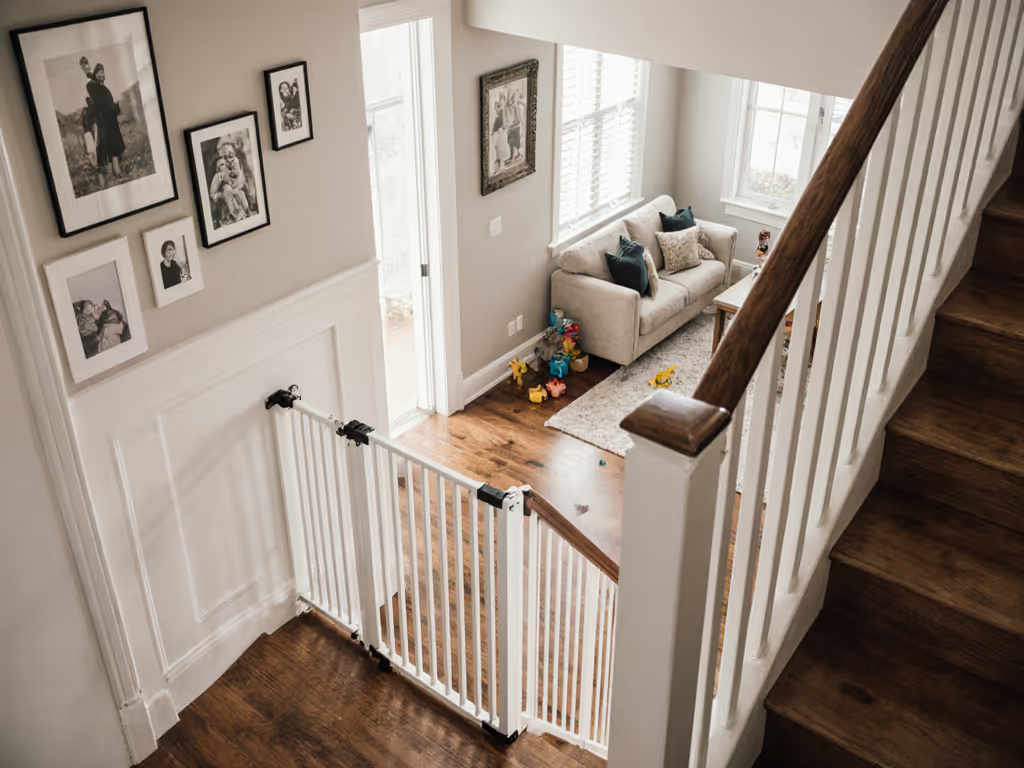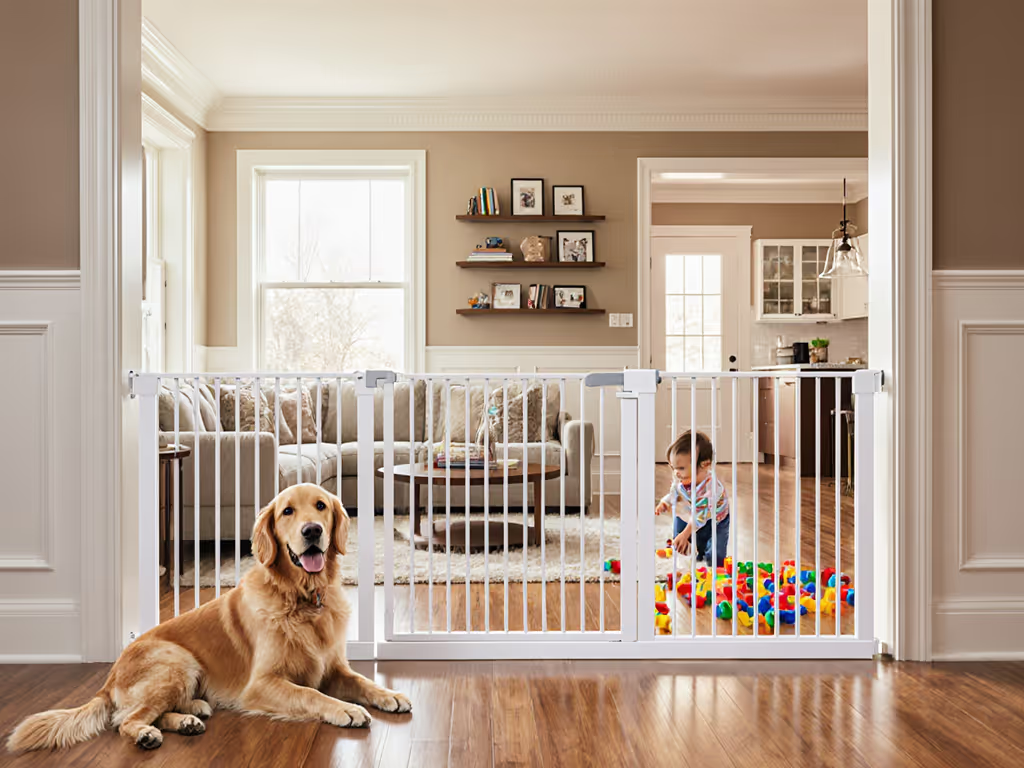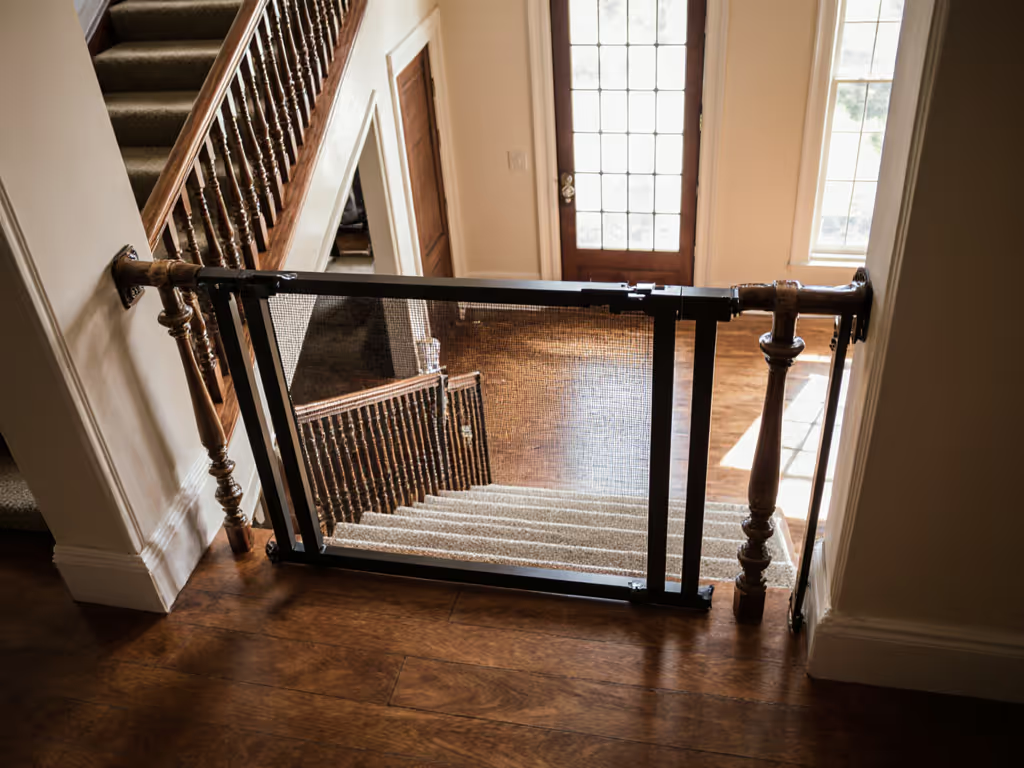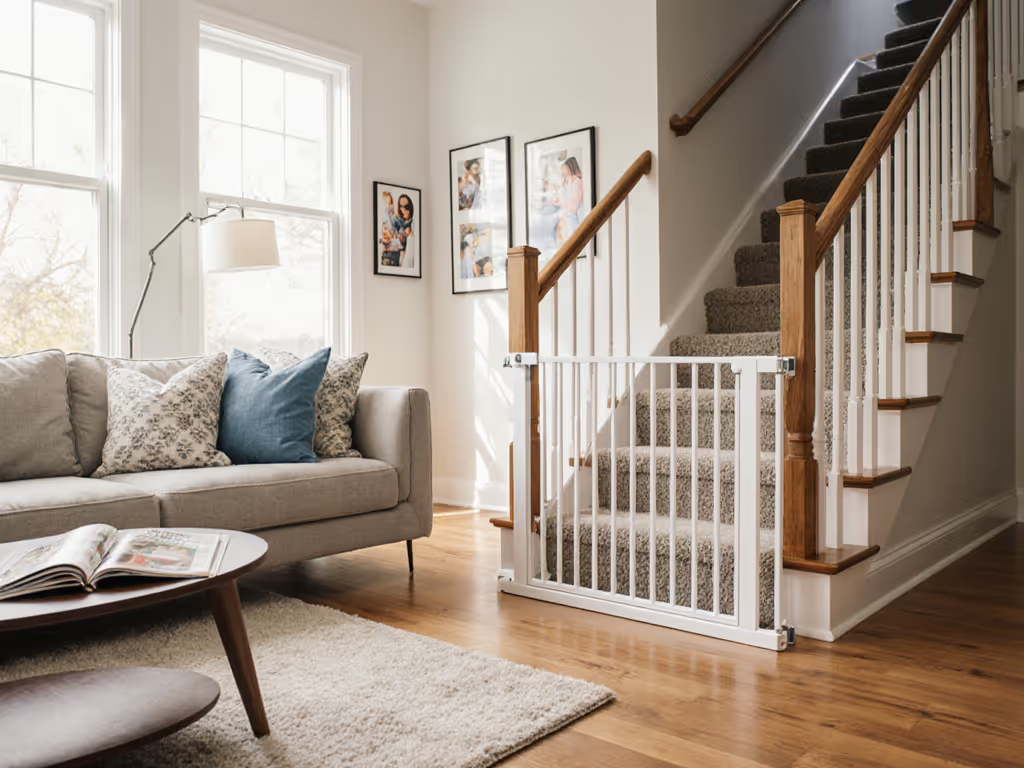
7 Essential Safety Standards for Gates Every Home Needs
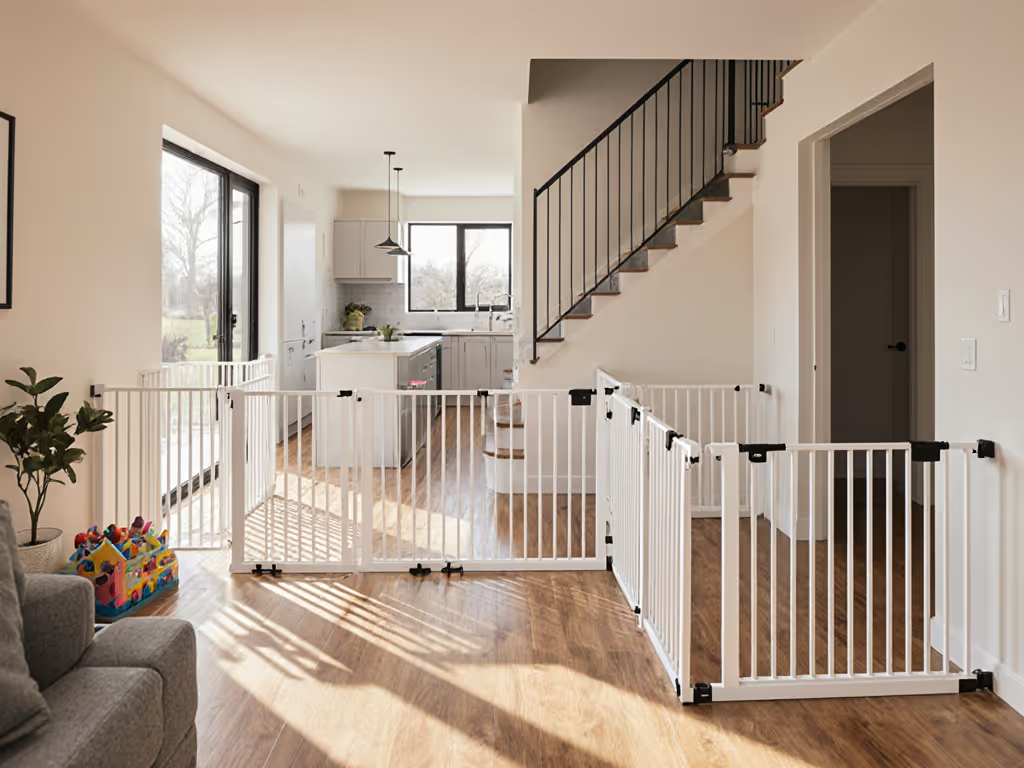
Did you know that nearly 70 percent of childhood injuries at home involve everyday barriers like gates that fail to meet basic safety standards? Keeping your family safe starts with more than just picking a sturdy design. Reliable safety gates are engineered to pass strict certifications, use safe materials, and fit your home’s risk zones with precision. Understanding how to spot these features gives you real confidence every time you close that gate.
Quick Summary
| Takeaway | Explanation |
|---|---|
| 1. Understand safety certifications | Look for ASTM or BS EN labels to ensure gates meet safety standards. |
| 2. Measure gate dimensions carefully | Check bar spacing, height, and gaps to prevent child entrapment. |
| 3. Choose secure locking mechanisms | Locks should be tamper-resistant and easy for adults but difficult for kids. |
| 4. Use durable, non-toxic materials | Select gates made from safe materials that resist wear and harsh conditions. |
| 5. Maintain and inspect regularly | Schedule monthly checks and document maintenance to ensure ongoing safety. |
1. Understanding Gate Certification Labels
When purchasing a safety gate for your home, decoding those certification labels can feel like solving a complex puzzle. But understanding these standards is your first line of defense in protecting your loved ones.
Safety certification labels are not just fancy stickers. They represent rigorous testing and compliance with industry standards that directly impact your family's protection. Take the ASTM F2200 standard, which specifically focuses on reducing injury risks in gate design. This certification means the gate has undergone extensive evaluation to minimize potential hazards.
What makes these certifications crucial? They provide independent verification that a gate meets specific safety benchmarks. For instance, the BS EN 12453:2017 standard outlines comprehensive safety requirements for power operated gates, ensuring they are designed with user protection in mind.
When shopping for gates, look for these key markers:
- ASTM certification: Indicates compliance with American safety standards
- BS EN certification: Represents European safety compliance
- Detailed manufacturer testing documentation
Remember that certification labels are your silent guardians. They communicate critical information about structural integrity, mechanical performance, and potential risk mitigation. By understanding these labels, you transform from a simple consumer into an informed safety advocate for your home.
Practical tip: Always request and review the full certification documentation when purchasing a gate. Don't just look at the label ask questions about what specific tests the gate has passed.
2. Choosing Gates with Safe Spacing and Height
Not all safety gates are created equal. The spacing between bars and the overall height can mean the difference between protection and potential danger for your children or pets.
Gate spacing is more than a design detail it is a critical safety feature. Research from workplace safety guidelines highlights the importance of eliminating potential crushing points and entrapment zones. According to EN ISO 14122-3:2016, gaps between railings and floor must not exceed 500mm to ensure maximum safety.
When evaluating a gate's safety, focus on three key dimensions:
- Vertical bar spacing: Should be narrow enough to prevent children from squeezing through
- Total gate height: Must be tall enough to prevent climbing
- Bottom gap: Minimal space between gate and floor to prevent small bodies from crawling underneath
Parents often overlook these subtle yet significant design elements. A gate might look sturdy, but wide gaps can become unexpected escape routes for curious toddlers. Imagine a child discovering a 4-inch opening as an invitation for adventure.
Practical measurement tips:
- Use a standard ruler to check bar spacing
- Ensure no opening is wider than 2.5 inches
- Verify the gate is at least 3/4 of your child's height
Think of your safety gate as a personal security guard for your little ones. Its job is not just to stand in place but to create an absolute barrier that adapts to your specific household needs.
Pro tip: When purchasing, always physically measure and test the gate. Visual inspection is good, but hands on verification is your best safety strategy.
3. Ensuring Secure Locking Mechanisms
A gate is only as good as its lock. What looks like a simple mechanism can become your home defense strategy against curious children and unexpected entry points.
Locking mechanisms are the silent guardians of your safety infrastructure. Research from home security experts emphasizes that lockable gates are not just recommended they are essential for comprehensive protection. Powered gates require especially sophisticated locking systems that prevent unauthorized access while responding safely to interactions.
Not all locks are created equal. You want a mechanism that offers multiple layers of security:
- One hand operation: Easy for adults, impossible for children
- Auto closing features: Ensures gate remains secure
- Tamper resistant design: Prevents accidental opening
Children are natural problem solvers with an uncanny ability to manipulate seemingly secure systems. A good lock stops them in their tracks without requiring constant parental supervision. Think of it as a gentle but firm guardian that says "not today" to wandering explorers.
What to look for in a gate lock:
- Smooth sliding or clicking mechanisms
- No sharp edges
- Requires deliberate adult level pressure to open
- Visual indicator when locked
Your goal is creating a barrier that looks straightforward to an adult but feels like an impenetrable fortress to a child. A quality lock transforms a simple gate from a suggestion into an absolute boundary.
Practical tip: Regularly test your gate lock. Periodically check that the mechanism remains tight and responsive. What worked six months ago might need adjustment now.
4. Selecting Non-Toxic and Durable Materials
Your safety gate is more than a barrier it is an investment in your family's protection. The materials you choose determine how well that protection performs under real world conditions.
Material selection goes far beyond aesthetic preferences. High quality gates leverage advanced engineering polymers designed to withstand intense daily interactions. Consider how gates from specialized safety manufacturers use High Impact Thermoplastic Engineered Polymer, which offers remarkable durability and resistance to harsh environmental conditions.
What makes a material truly safe and reliable? Look for these critical characteristics:
- Chemical stability: No leaching of harmful substances
- Impact resistance: Ability to absorb unexpected forces
- Temperature tolerance: Performs consistently in different environments
- Non reactive surfaces: Prevents potential allergic responses
Parents often underestimate how much abuse a safety gate experiences. Between curious children pulling, pushing, and climbing and pets bumping against it constantly your gate needs serious structural integrity.
Material evaluation checklist:
- Inspect surface smoothness
- Check for potential sharp edges
- Verify material flexibility
- Confirm manufacturer testing documentation
Think of your gate material like body armor for your home. It needs to be tough yet flexible, protective without being intimidating. The right material creates a safety barrier that feels natural and seamless in your living space.
Practical tip: When shopping, ask manufacturers about their material testing protocols. Reputable companies will gladly share detailed information about their gate materials performance under stress.
5. Proper Gate Placement for Risk Areas
Gate placement is not about random installation but strategic protection. Every inch of placement can mean the difference between safety and potential risk for your family.
Identifying high risk zones is your first critical step. Security experts emphasize that gates are more than barriers they are intelligent access control systems. Whether protecting children from stairs or blocking dangerous areas like kitchen zones and home workshops, strategic placement becomes your silent guardian.
When mapping out gate locations, consider these primary risk assessment zones:
- Staircase entrances: Prevent falls on upper and lower levels
- Kitchen perimeters: Block access to hot surfaces and sharp objects
- Home office or workshop areas: Restrict entry to potentially dangerous equipment
- Exterior transitions: Control access between indoor and outdoor spaces
Think of gate placement like creating a protective force field around your most vulnerable family members. Each gate serves as a targeted intervention preventing potential accidents before they can happen.
Strategic placement recommendations:
- Measure doorway and entrance widths precisely
- Consider swing direction and potential obstruction
- Evaluate mounting surface stability
- Check for potential interference with daily traffic flow
Your home has unique architectural characteristics. What works in one space might fail in another. Professional installers recommend a comprehensive walkthrough to identify every potential risk point.
Practical tip: Walk through your home from a child perspective. Get down to their eye level and imagine potential exploration routes. This perspective will reveal gate placement opportunities you might have overlooked.
6. Regular Maintenance and Safety Checks
A safety gate is not a set and forget solution. Like any critical home safety system, it demands consistent attention and proactive care to remain effective.
Maintenance is the heartbeat of gate reliability. Industry standards like BS EN 12453:2017 emphasize that ongoing safety checks are not optional they are essential. Powered gates and manual safety barriers alike require systematic evaluation to prevent potential failures that could compromise your family's protection.
Think of gate maintenance like a routine health checkup for your home's safety infrastructure:
- Structural integrity checks: Examine mounting points and frame stability
- Mechanical function testing: Verify smooth operation of locks and hinges
- Material condition assessment: Look for signs of wear rust or degradation
- Hardware connection inspection: Ensure all components remain securely fastened
Your maintenance routine should feel like a rhythmic dance of prevention. Children and pets create dynamic environments that constantly challenge your gate's performance. What worked flawlessly six months ago might need adjustment now.
Recommended maintenance frequency:
- Monthly visual inspections
- Quarterly functional tests
- Annual comprehensive professional evaluation
- Immediate attention after significant impacts or unusual stress
Professional safety experts understand that consistent small interventions prevent major failures. A loose screw today could become a significant safety risk tomorrow. Your vigilance transforms a simple gate into a reliable guardian.
Practical tip: Create a maintenance log. Document each inspection date observations and actions taken. This creates accountability and helps you track your gate's long term performance.
7. Installing According to Manufacturer Guidelines
That little instruction manual tucked inside your safety gate package is not just paper it is your blueprint for family protection. Manufacturer guidelines are not bureaucratic suggestions they are precision instructions designed to keep your loved ones safe.
Installation is a science not an art. Safety experts consistently emphasize that following manufacturer guidelines ensures powered gates operate with maximum effectiveness and minimal risk. One missed step can transform a protective barrier into a potential hazard.
Think of installation guidelines like a mission critical roadmap:
- Precise mounting instructions: Specific wall attachment requirements
- Weight distribution recommendations: Ensuring structural integrity
- Required tools and hardware: Preventing improvised solutions
- Clear spacing measurements: Maintaining optimal safety zones
Most installation failures happen not from complex challenges but from overlooking seemingly minor details. A screw placed incorrectly or a bracket mounted at the wrong angle can compromise your entire safety system.
Recommended pre installation preparation:
- Read entire manual before starting
- Gather all specified tools in advance
- Verify mounting surface compatibility
- Take measurements multiple times
- Double check hardware specifications
Your gate is more than a physical barrier. It represents a commitment to protecting what matters most. Professional installers understand that precision is not about perfection it is about predictable safety.
Practical tip: Take photos during installation. Document each step and mounting point. These can serve as future reference and help during maintenance or potential warranty claims.
Below is a comprehensive table summarizing key aspects of gate certification, safety considerations, and maintenance steps discussed throughout the article.
| Topic | Description | Key Considerations |
|---|---|---|
| Certification Labels | Gates should meet standards like ASTM F2200 and BS EN 12453:2017. | Request full documentation and verify tested features. |
| Gate Spacing & Height | Proper spacing and height prevent injuries and escapes. | Measure to ensure vertical bar spacing and total height suffices. |
| Locking Mechanisms | Essential for safety, with auto-closing and tamper-resistant features. | Check for ease of adult use and prevention of child access. |
| Material Selection | Use high-quality, non-toxic, and durable materials. | Confirm chemical stability and impact resistance. |
| Gate Placement | Strategically place gates in high-risk zones like stairs and kitchens. | Evaluate physical layout and traffic flow. |
| Maintenance and Checks | Regular inspections ensure long-term safety and reliability. | Maintain routine checks with a documented log. |
| Installation Guidelines | Follow manufacturer instructions precisely for safety. | Prepare thoroughly and verify details before starting. |
Ready to Make Gate Safety Simple and Stress-Free?
You have just learned how crucial certified standards, safe spacing, secure locks, and material durability are for protecting your home. But putting these guidelines into practice can feel overwhelming, especially when every detail has real consequences for your child's safety. Choosing the right gate that truly meets ASTM and BS EN standards is not just about peace of mind. It is about preventing accidents before they happen.
Take the guesswork out of safety. Visit https://babysafetygates.world for trusted advice, step-by-step installation tips, and expert recommendations tailored to your unique needs. Our detailed product reviews and in-depth guides will help you compare options and avoid common mistakes covered in the article. Make your next move a confident one—explore the best safety gate solutions for your family at https://babysafetygates.world and take action today for a safer tomorrow.
Frequently Asked Questions
What are gate certification labels, and why are they important?
Safety gate certification labels indicate compliance with established safety standards like ASTM F2200 and BS EN 12453:2017. These labels ensure that the gate has been rigorously tested for safety, providing peace of mind for families. Always look for these certifications when purchasing a gate to ensure it meets necessary safety benchmarks.
How do I assess the spacing and height of a safety gate for my home?
When selecting a safety gate, ensure that vertical bar spacing is narrow enough to prevent children from slipping through, generally no wider than 2.5 inches. Additionally, the gate height should be at least 3/4 of your child's height to deter climbing. Measure these dimensions carefully to enhance safety in your home.
What features should I look for in a secure gate locking mechanism?
A secure gate locking mechanism should allow for one-handed operation by adults but be difficult for children to unlock. Look for features such as auto-closing mechanisms and tamper-resistant designs, which ensure the gate remains securely closed. Regularly test these locks to maintain their effectiveness over time.
What materials are recommended for durable and non-toxic safety gates?
Select safety gates made from high-quality materials, such as impact-resistant polymers that provide durability without leaching harmful substances. Always verify that the materials are non-reactive and suitable for the expected wear and tear from children and pets. Request documentation on material testing to validate their safety and durability.
How should I strategically place safety gates throughout my home?
Assess high-risk zones in your home, such as staircase entrances and kitchens, and install gates in these critical areas to prevent accidents. Take precise measurements of doorways and consider the swing direction of the gate. This strategy enhances safety by controlling access to potentially dangerous spaces.
How often should I perform maintenance checks on my safety gates?
Conduct a visual inspection of your safety gates monthly and perform functional tests quarterly to ensure they are operating smoothly. Additionally, schedule a comprehensive professional evaluation annually to address any potential issues. Keeping a maintenance log can help track inspections and interventions over time.

